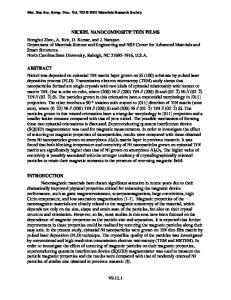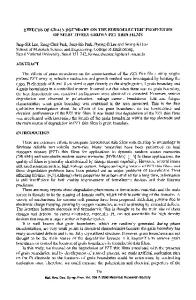Study of the Effects of Si Addition on the Properties of Hard Nanocomposite Thin Films
- PDF / 1,791,427 Bytes
- 5 Pages / 612 x 792 pts (letter) Page_size
- 56 Downloads / 308 Views
0976-EE03-18
Study of the Effects of Si Addition on the Properties of Hard Nanocomposite Thin Films Jose Luis Endrino1, Sergio Palacin2, Alejandro Gutierrez2, Myriam Aguirre3, and Franz Schäfers4 1 Plasma Applications Group, Lawrence Berkeley National Laboratory, 1 Cyclotron Rd. Building 53, Berkeley, CA, 94720 2 Universidad Autonoma de Madrid, Madrid, Spain 3 Empa-Swiss Federal Lab for Materials Testing and Research, Duebendorf, Switzerland 4 BESSY GmbH, Berlin, Germany
ABSTRACT In the present study, hard TiSiN coating compounds with different Si content have been deposited by the magnetron sputtering technique. X-ray diffraction (XRD) and X-ray absorption spectroscopy (XAS) have been employed to investigate the effects of Si addition on the composition, structure and phase development of the cubic NaCl-type structure. To get some insight on these changes, X-ray absorption spectra have been measured at the Ti and Si K-edges in fluorescence yield mode. The collected data showed that the interaction between Ti and Si was weak and the formation of a-Si3N4 can be assumed. Hardness measurements were also consistent with the formation of hard nanocomposite films. A maximum hardness of about 36 GPa was obtained for the sample with 11 at. % Si. INTRODUCTION Addition of silicon to TiN coatings can significantly influence their texture, phase formation and grain size. Nanocomposite materials can exhibit high hardness and possess a high resistance to oxidation, which results in a broad range of mechanical applications [1]. The formation of two-phase nanocomposite systems composed of amorphous Si3N4 and nanocrystalline metallic nitride phases has been extensively reported in both transition metal nitride and carbide compounds [2-4]. The low solubility of silicon in the lattice of fcc-NaCl structured nitrides has been explained by the higher mixing enthalpy of complex ternary or quaternary nitride compounds when compared to the lower free energy of MeN and a-Si3N4 phases [5]. TiSiN coatings have been subject of detailed structural and chemical characterization by a wide number of analytical techniques [6]. This work reports on the local structure and bonds of titanium and silicon in TiSiN thin films by combining x-ray diffraction (XRD) and the x-ray absorption (XAS) techniques. EXPERIMENTAL DETAILS TiSiN coatings investigated in this research were deposited using dual pulsed magnetron sputtering from Ti and Si targets in an Ar/N2 atmosphere. Mirror-polished squared cemented carbide inserts were used as substrates. The thickness of all the coating samples was within 3.5 ± 0.2 µm. A Siemens D500 diffractometer with a CuKα tube and the Θ/2Θ mode was used to perform XRD analysis and identify the phases formed. Chemical analysis was performed on a Field Emission SEM (LEO 1550 FEG) equipped with INCA Energy Dispersive Spectroscopy
(EDS). XAS measurements of the Ti and Si K-edges were carried out at the KMC-1 beamline of the BESSY synchrotron facility with double crystal monochromator using a standard chamber equipped with a high-
Data Loading...










